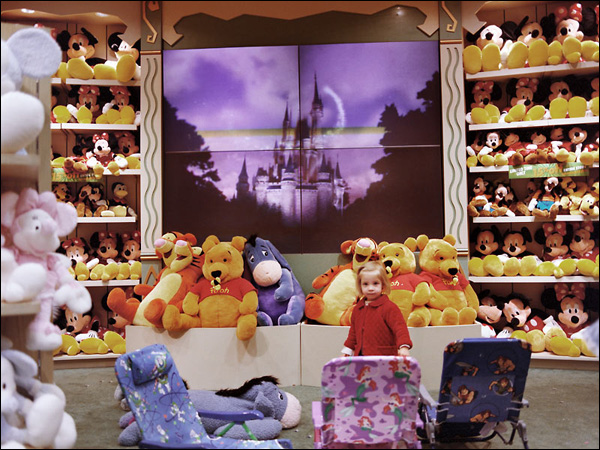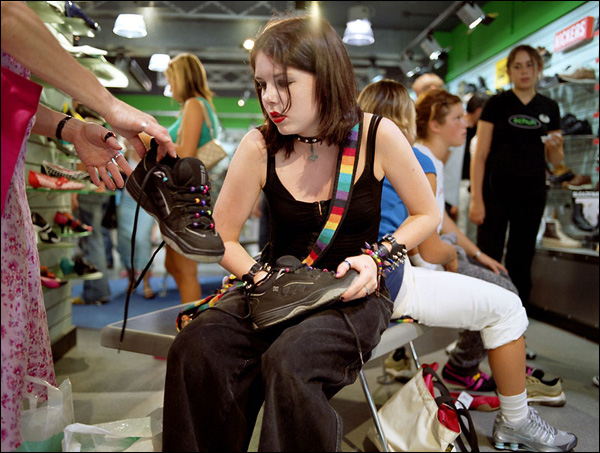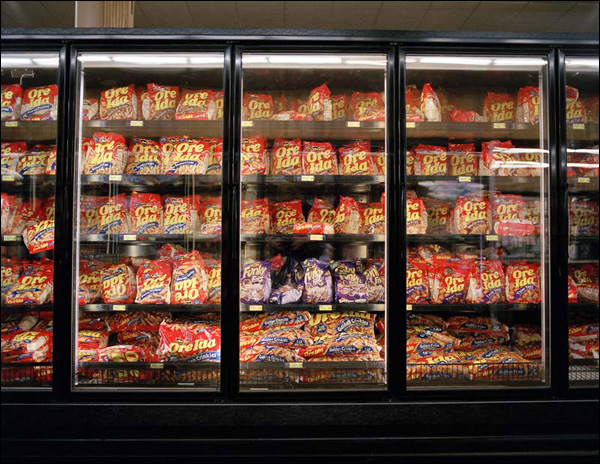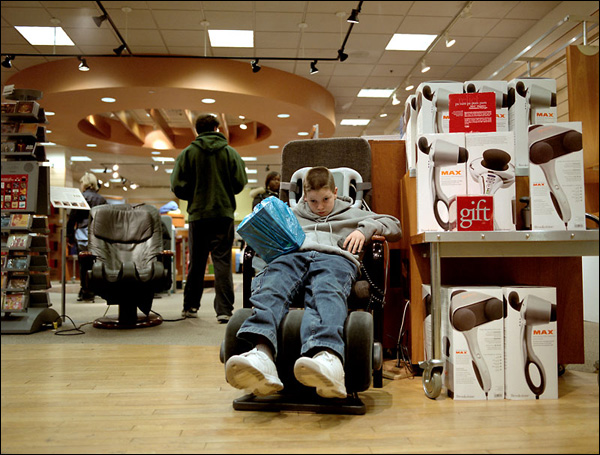 |
 | ||
|
Brian Ulrich's Copia Documentary photographer Brian Ulrich captures affluent society at the dawn of the 21st century in "Copia," a long-term photographic inquiry into Americans shopping. After President Bush's 2001 exhortation to go out and shop, Ulrich says he wondered, "Were people really patriotically shopping?" Indeed, he found they were. Ulrich began a documentary project called Copia which he says "explores not only the everyday activities of shopping, but the economic, cultural, social, and political implications of commercialism and the roles we play in self-destruction, over-consumption, and as targets of marketing and advertising." Here is a sampling of Copia. The full project can be found at http://www.notifbutwhen.com.
Granger, IL 2003
Ulrich was interested in retail design and its effect on consumerism. He visited big box stores to take pictures and study what was going on. He says the project has attracted lots of interest, sometimes from surprising corners. This image shot in Granger, Illinois was purchased by the Museum of Fine Arts which is sponsored by Target. Ulrich told ARW it's a "weird circle" and muses, "In a way, this is sort of advertising for their brand in the museum sense."
Cleveland, OH 2003
"I have more photographs of kids than any other age group because they're the most marketed to in our society," says Ulrich. In this Disney Store in Cleveland, Ohio, Ulrich says he was struck by the girl's expression, and the placement of so many toys out of her reach. "She's completely subsumed by the surroundings. She looks a little bit lost in there, like some sad Winnie the Pooh doll," he says.
Chicago, IL 2003
Ulrich doesn't ask shoppers if he can photograph them, and he says most of them never have any idea he's taken their picture. "If I'm standing next to someone, they'll think I'm shopping too," he says. Ulrich picks a good background and waits for someone to walk into the picture. He says he was inspired by Walker Evans' subway series in the 1930s. Evans kept a camera hidden in his jacket that was pre-focused because the distance to the seat across from him never changed. "I really liked the way that makes these pictures very unstudied, very real," he says. Ulrich wants members of his audience to recognize their own role as shoppers and question it. "People will come back to me and say, 'I can't go into these places without thinking of your pictures.' It's a wonderful completion of the project," he says.
Edinburgh, UK 2003
Ulrich calls this image an example of serendipity when he's out shooting. As he tells it, "I'm sitting across from this girl and I just love that she's just really, she's so cute trying to look so tough." And he notices something else. "It's almost as if the store quite sophisticatedly knows what her identity type is. The shoe matches her entire outfit before she's bought the thing."
Kenosha, WI 2003
"I love making references to art in photography," says Ulrich when asked about Ore Ida's sweeping real estate in the freezer section. "People will ask if it's been photoshopped. It really is three full freezer cases of French fries!" says Ulrich with a laugh. He's intrigued by how profitable it is for big box stores to rent out space within their stores. For example, he learned brands might rent the most profitable freezer cases and fill them all with French fries. "As much as it's easy to be quite critical of people shopping, consuming, buying 4,000 French fries, we also realize that not a lot of this is dictated by us. As these stores become more and more owned by three major corporations and distributors, they're the ones who decide what we eat as an entire Western culture, what we wear, our music. It led me to investigate."
Smithhaven, NY 2003
This image was taken at a mall Ulrich used to visit as a child. The shot wasn't planned though. "Sometimes I will find a very dramatic backdrop and wait for someone to walk into it. This was right in the front entrance, and this kid was into his massage. He looks so adult like, he's kind of aping what dad might do there." The glazed expression on the child's face is a common theme in Copia. "That stare is something I really like and you find a lot in my pictures…The setting of the picture becomes the answer for why they're looking that way. They're overwhelmed." Ulrich says.
When asked if Copia has changed Ulrich's shopping habits he answers quickly, "Of course!... It stripped away the illusion. It's not really very glamorous. It's trying to be quite clever, but once you realize how this stuff works visually, it's really not that clever. Luckily, I have a good sense of humor about the world." Copia is a multi-year project with chapters called "retail," "thrift" (featuring thrift stores) and "backrooms," a glimpse behind the scenes of retail America.
Back to Design of Desire | ||





